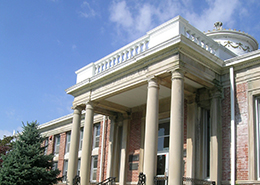Social Equity — Education

Up until the 1950s, racial segregation was the norm for many public shcools throughout the Unite States, including some in Chester County. The long-term impacts of this discrimination are still present today, making education one of the most discussed topics regarding social equity. However, education is not limited only to public schools or colleges and universities. Access to libraries and the internet are important means for education, as well as classes for adult literacy and English as a second language.
View mapping illustrating social equity and education in Chester County. This mapping addresses: Level of education; language spoken at home; and computer access at home.
Education and Education Levels
Disadvantaged families often have less access to educational opportunities relative to higher income families. Since public education is largely funded by real estate taxes, disadvantaged neighborhood whose property values are lower commonly do not have sufficient funding to pursue the sort of public education initiatives that are available in wealthier communities. As the chart below shows, there are disparities in education levels between the major race and ethnicity cohorts in Chester County.
Chester County Education by Selected Race/Ethnicity
Source: US Census Bureau, 2021 American Community Survey 1-Year Estimates, S1501.
Some useful websites that address this issue include:
- PA Department of Education: What is Equity
- US Department of Education: Department of Education Releases Equity Action Plan as Part of Biden-Harris Administration's Efforts to Advance Racial Equity and Support Underserved Communities, April 14, 2022
- National Science Foundation: Racial Equity in STEM Education (EHR Racial Equity)
- Brookings: Unequal Opportunity: Race and Education
Library Access
Public libraries serve an important role in education since they can be accessed on evenings and weekends when public schools are closed. Libraries are also places that can be visited by older children without adult supervision and are popular with senior citizens who may not be skilled gathering information from the Internet. Also, for economically disadvantages household, libraries provide reading materials for free as well as internet access. Many of hte CCLS libraries are located in the county's more disadvantaged communities. 
The Chester County Library System pursues social equity initiatives through its Equity, Diversion, and Inclusion Committee. Their ongoing initiatives at their 18 member CCLS locations include:
- Accessibility for patrons of varied abilities,
- The Justice-involved Youth Project,
- Expanding World Languages sections, and
- Chinese bi-lingual programming and materials.
Some useful websites that address this issue include:
- New York Public Library: Racial Equity Resources for Educators
- American Library Association: Equality and Equity of Access: What's the Difference?
- The Government Alliance on Race and Equity (University of California, Berkeley): Advancing Racial Equity in Public Libraries, Case Studies from the Field
- Public Library Association: Advancing Racial Equity in Your Library
Internet or Computer at Home
In the past few decades, Internet use has become an essential part of daily life for most Americans. Yet the cost of Internet equipment and service can still be out of reach for low-income individuals. Furthermore, high speed internet is not always available in areas with low population density or with environmental limitations like nearby mountains. In Chester County, 92.5% of the population owns a computer and has access to broadband. And yet, as the chart below shows, there is a race and ethnicity based difference in access to broadband.
Chester County Internet Access by Selected Race/Ethnicity
Source: US Census Bureau, 2020 American Community Survey 5-Year Estimates, S2802.
Some useful websites that address this issue include:
- Federal Communications Commission: Advancing Broadband Connectivity as a Social Determinant of Health
- Brookings: Digital prosperity: How broadband can deliver health and equity to all communities
- National Consumer Law Center: Broadband Service is a Racial Equity Priority
- National Library of Medicine: Social equity and access to the World Wide Web and E-mail: implications for design and implementation of medical applications
- Annenberg School for Communications: Policing the Digital Divide: How Racial Bias Can Limit Internet Access for People of Color
English as a Second Language, and Adult Literacy and Education
In some disadvantaged communities, some of the barriers to career advancement is low proficiency in English or an overall limited reading skill. While there is no question that the key to overcoming these deficiencies is education, the time and funding needed for such educational programs is not always available. As the table below shows, Chester County has over 65,000 residents who speak a language other than English, of whom just over 20,000 do not speak English with proficiency.
English as a Second Language in Chester County

Source: US Census Bureau, 2021 American Community Survey 1-Year Estimates, S1601.
Some useful websites that address this issue include:
- National Coalition for Literacy: Access and Inclusion, Adult Literacy Education and Literacy Priorities for 2021 and beyond
- Pennsylvania Adult Education Resources: Equity and Education
- Walmart.org Center for Racial Equity Update: Creating Career Pathways through Education
- Penn State College of Education: Office of Education and Social Equity

